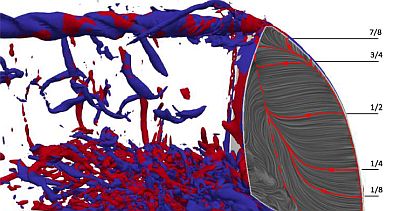
Delayed Detached Eddy Simulation of Yacht Sails with experimental validation
Ponzini Raffaele - CINECA (Italy)
Bartesaghi Simone - Politecnico di Milano (Italy)
Van Renterghem Thomas - Arts et Métiers ParisTech (France)

PRESENTATION
Abstract
Recent advances in sail aerodynamics allowed to improve sails aerodynamics efficiency. However, the characteristics of those flow features that allow sails to be highly efficient remain mostly unknown. The understanding of such features will allow further enhancing of sail performances and enabling a more effective knowledge transfer towards those fields where thin airfoils are used, such as, for instance, autonomous air and underwater vehicles, small wind turbines, piercing and reversible propellers. Moreover, the study of turbulent structures around complex three dimensional geometries and curved surfaces under high lift conditions, and their interaction with local flow fields where laminar to turbulent transition, separation and reattachment play a major role, is very challenging both numerically and experimentally. These challenges can now be solved using advanced numerical methods and high performance computing resources. In the present work, for the first time, we investigate the taxonomy and the characterization of the turbulent structures around yacht sails in order to gain new insights on the flow features that make sails highly aerodynamically efficient. In details we performed the first Delayed Detached Eddy Simulation (DDES) of yacht sails, which were previously extensively studied using traditional experimental facilities (wind-tunnel). Different mesh sizes - from 4 to 32 million cells - have been build and the scalability on up to 256 computational cores has been tested. About twenty loops (5.2 seconds/loop) of the whole domain using time steps from 5∙10^-4 to 2∙10^-3 seconds have been performed in order to obtain statistically reliable data and to perform a comparison with the experimental results of pressures over the sails surfaces. The numerical/experimental comparison showed similarities and differences which are discussed in the full paper. Moreover, thanks to the advanced modelling technique, firstly tested herein on this kind of application, coherent turbulent structures have been highlighted and visualized. The control of these quantities will allow enhancing the efficiency of future sails, leading to more competitive sailing yachts. Also, the possibility of reproducing these features in different conditions and on different geometries will improve the fluid dynamic performance of wings and propellers adopted in a wide range of engineering applications. Future benchmarks are planned to evaluate the improvements of the overall computational performances on novel hardware architectures and shrink the time consumption allowing for an effective integration of these techniques on industrial design and optimization processes.
